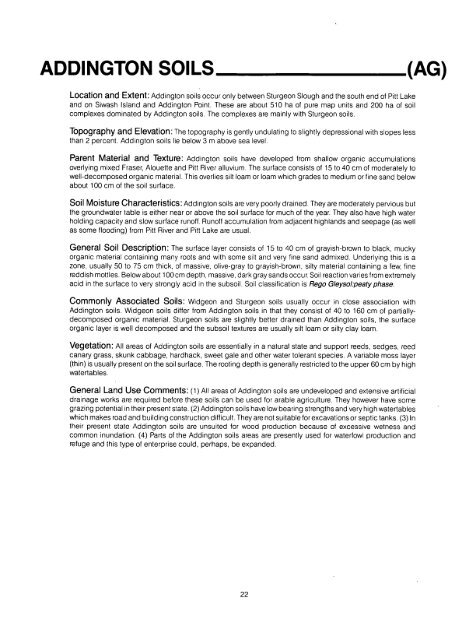Soils of the - Agriculture and Agri-Food Canada
Soils of the - Agriculture and Agri-Food Canada
Soils of the - Agriculture and Agri-Food Canada
Create successful ePaper yourself
Turn your PDF publications into a flip-book with our unique Google optimized e-Paper software.
ADDINGTON SOILS (AG)<br />
Location <strong>and</strong> Extent : Addington soils occur only between Sturgeon Slough <strong>and</strong> <strong>the</strong> south end <strong>of</strong> Pitt Lak e<br />
<strong>and</strong> on Siwash Isl<strong>and</strong> <strong>and</strong> Addington Point . These are about 510 ha <strong>of</strong> pure map units <strong>and</strong> 200 ha <strong>of</strong> soi l<br />
complexes dominated by Addington soils . The complexes are mainly with Sturgeon soils .<br />
Topography <strong>and</strong> Elevation : The topography is gently undulating to slightly depressional with slopes les s<br />
than 2 percent . Addington soils lie below 3 m above sea level .<br />
Parent Material <strong>and</strong> Texture : Addington soils have developed from shallow organic accumulation s<br />
overlying mixed Fraser, Alouette <strong>and</strong> Pitt River alluvium . The surface consists <strong>of</strong> 15 to 40 cm <strong>of</strong> moderately t o<br />
well-decomposed organic material . This overlies silt loam or loam which grades to medium or fine s<strong>and</strong> below<br />
about 100 cm <strong>of</strong> <strong>the</strong> soil surface .<br />
Soil Moisture Characteristics : Addington soils are very poorly drained . They are moderately pervious bu t<br />
<strong>the</strong> groundwater table is ei<strong>the</strong>r near or above <strong>the</strong> soil surface for much <strong>of</strong> <strong>the</strong> year. They also have high wate r<br />
holding capacity <strong>and</strong> slow surface run<strong>of</strong>f . Run<strong>of</strong>f accumulation from adjacent highl<strong>and</strong>s <strong>and</strong> seepage (as wel l<br />
as some flooding) from Pitt River <strong>and</strong> Pitt Lake are usual .<br />
General Soil Description : The surface layer consists <strong>of</strong> 15 to 40 cm <strong>of</strong> grayish-brown to black, muck y<br />
organic material containing many roots <strong>and</strong> with some silt <strong>and</strong> very fine s<strong>and</strong> admixed . Underlying this is a<br />
zone, usually 50 to 75 cm thick, <strong>of</strong> massive, olive-gray to grayish-brown, silty material containing a few, fin e<br />
reddish mottles . Below about 100 cm depth, massive, dark gray s<strong>and</strong>s occur . Soil reaction varies from extremel y<br />
acid in <strong>the</strong> surface to very strongly acid in <strong>the</strong> subsoil . Soil classification is Rego Gleysol:peaty phase.<br />
Commonly Associated <strong>Soils</strong> : Widgeon <strong>and</strong> Sturgeon soils usually occur in close association wit h<br />
Addington soils . Widgeon soils differ from Addington soils in that <strong>the</strong>y consist <strong>of</strong> 40 to 160 cm <strong>of</strong> partially -<br />
decomposed organic material . Sturgeon soils are slightly better drained than Addington soils, <strong>the</strong> surfac e<br />
organic layer is well decomposed <strong>and</strong> <strong>the</strong> subsoil textures are usually silt loam or silty clay loam .<br />
Vegetation : All areas <strong>of</strong> Addington soils are essentially in a natural state <strong>and</strong> support reeds, sedges, ree d<br />
canary grass, skunk cabbage, hardhack, sweet gale <strong>and</strong> o<strong>the</strong>r water tolerant species . A variable moss laye r<br />
(thin) is usually present on <strong>the</strong> soil surface . The rooting depth is generally restricted to <strong>the</strong> upper 60 cm by hig h<br />
watertables .<br />
General L<strong>and</strong> Use Comments : (1) All areas <strong>of</strong> Addington soils are undeveloped <strong>and</strong> extensive artificia l<br />
drainage works are required before <strong>the</strong>se soils can be used for arable agriculture . They however have som e<br />
grazing potential in <strong>the</strong>ir present state . (2) Addington soils have low bearing strengths <strong>and</strong> very high watertables<br />
which makes road <strong>and</strong> building construction difficult . They are not suitable for excavations or septic tanks . (3) I n<br />
<strong>the</strong>ir present state Addington soils are unsuited for wood production because <strong>of</strong> excessive wetness an d<br />
common inundation . (4) Parts <strong>of</strong> <strong>the</strong> Addington soils areas are presently used for waterfowl production an d<br />
refuge <strong>and</strong> this type <strong>of</strong> enterprise could, perhaps, be exp<strong>and</strong>ed .<br />
22

















